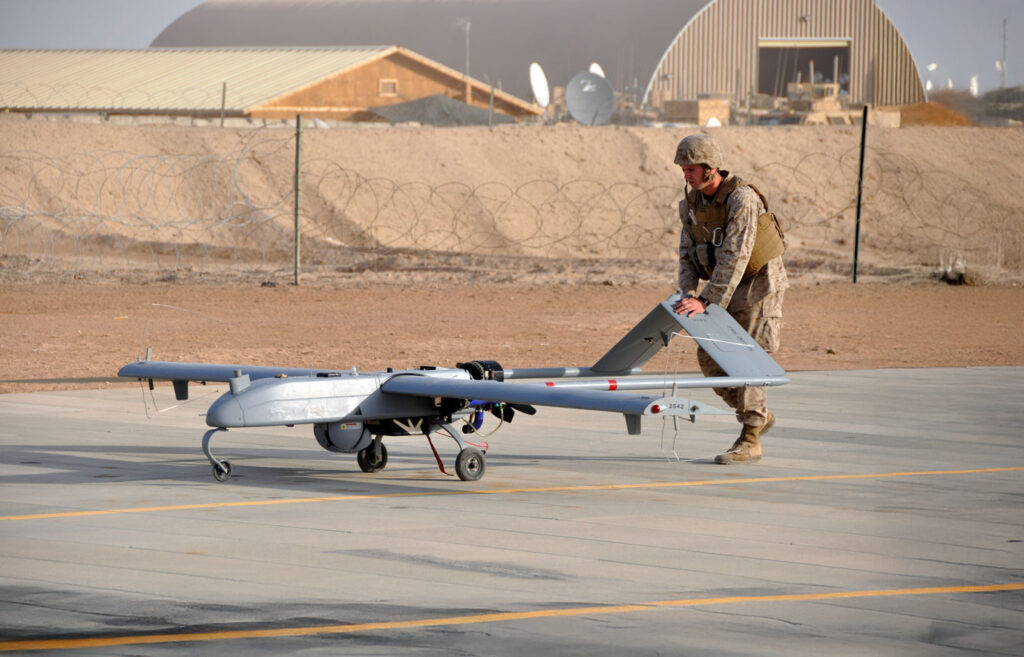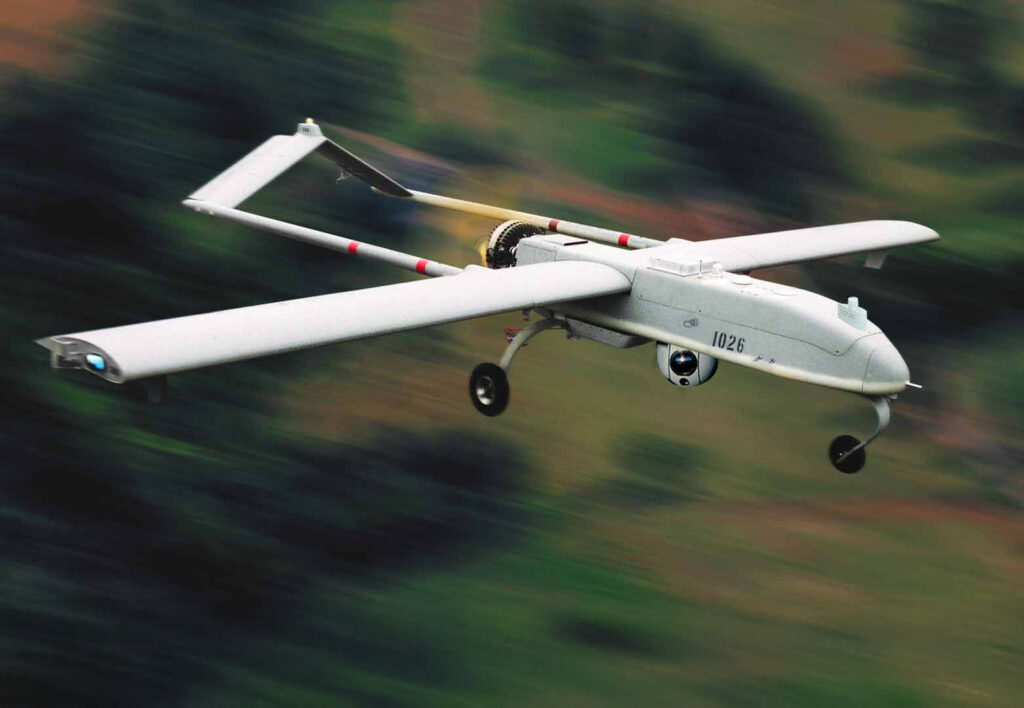AAI (Textron) RQ-7 Shadow: tactical UAV for surveillance, reconnaissance, and targeting with advanced electro-optical/infrared sensors.
In brief
The AAI (Textron) RQ-7 Shadow is a tactical unmanned aerial vehicle (UAV) designed for reconnaissance, surveillance, and targeting support. Developed in the late 1990s and early 2000s, the RQ-7 Shadow provides real-time, accurate intelligence to ground forces. It is powered by a Wankel rotary engine, capable of flying up to 15,000 feet (4,572 meters) with a maximum endurance of 6 hours. The UAV is equipped with electro-optical/infrared sensors for day and night operations, transmitting live video and laser target designations. The RQ-7 Shadow’s ability to launch from short runways or mobile launchers makes it highly versatile for forward-deployed units.

The AAI (Textron) RQ-7 Shadow
The AAI (Textron) RQ-7 Shadow was developed to meet the U.S. Army’s need for a reliable, tactical unmanned aerial vehicle (UAV) capable of providing real-time reconnaissance and surveillance. In the late 1990s, there was a pressing demand for tactical UAVs, especially in light of the U.S. military’s expanding need for intelligence gathering in conflict zones. With the increasing complexity of modern warfare, and the desire to minimize risk to personnel, the U.S. Army sought a UAV that could provide reconnaissance, surveillance, and targeting support in real-time, helping ground units maintain a tactical advantage.
In 1999, the U.S. Army awarded AAI Corporation (now Textron Systems) a contract to develop the RQ-7 Shadow UAV. The project was part of the Army’s Future Combat Systems initiative, aimed at enhancing battlefield awareness and reducing the reliance on manned aircraft for intelligence missions. The Shadow was designed to complement existing UAV platforms like the RQ-5 Hunter, which was larger and more expensive. The RQ-7 Shadow, being more compact, was intended for battalion-level use, providing a UAV option that could be easily deployed in various environments.
The first flight of the RQ-7 Shadow occurred in 2001. The UAV quickly became a crucial asset in operations requiring real-time intelligence. With its robust communication links and ability to relay live video, the RQ-7 provided critical data for ground forces. The Shadow was later integrated with various payloads, including advanced electro-optical and infrared sensors, making it highly versatile in day and night operations.
During its development, the Shadow received the NATO designation “RQ,” which stands for “Reconnaissance” and “Unmanned.” This designation classified it as a reconnaissance UAV, as opposed to armed drones. Despite its lack of direct combat capabilities, the RQ-7 Shadow proved to be invaluable in supporting combat operations by providing timely intelligence for targeting purposes. Its success in the field led to its widespread deployment by U.S. forces and several allied nations.
The RQ-7 Shadow was deployed extensively in both Iraq and Afghanistan. Its small size, endurance, and ability to launch from short runways or mobile catapult systems made it particularly suited for the rugged terrain and unpredictable combat conditions in those regions. The RQ-7 Shadow’s role in counterinsurgency operations proved essential, as it helped track enemy movements and provided reconnaissance for ground-based operations. The data collected by the RQ-7 Shadow was often used to direct artillery fire or coordinate airstrikes, giving ground forces a critical edge.
Design of the AAI (Textron) RQ-7 Shadow
The design of the RQ-7 Shadow reflects its primary purpose as a tactical UAV for reconnaissance and surveillance. With a wingspan of 14 feet (4.3 meters) and a length of 11 feet (3.4 meters), the RQ-7 is a relatively compact drone, allowing it to be easily transported and deployed in forward operating environments. The aircraft’s lightweight structure is composed of composite materials, which not only make it more agile but also enhance its durability during operations.
One of the key features of the RQ-7 Shadow is its propulsion system. It is powered by a Wankel rotary engine, the UAV engine of choice due to its high power-to-weight ratio and reliability. The engine provides 38 horsepower, which allows the Shadow to reach a maximum speed of 110 knots (203 km/h) and operate at altitudes of up to 15,000 feet (4,572 meters). The fuel-efficient design allows the UAV to remain airborne for up to 6 hours, providing extended reconnaissance coverage without frequent refueling.
The Shadow uses a modular payload system, which includes electro-optical (EO) and infrared (IR) sensors. These sensors enable the UAV to operate in both day and night conditions, capturing high-resolution imagery and real-time video for analysis. Additionally, the RQ-7 is equipped with a laser designator, allowing it to mark targets for precision-guided munitions. This capability significantly improves the accuracy of strikes carried out by other aircraft or ground-based artillery units.
Despite its advantages, the RQ-7 Shadow also has limitations. One notable drawback is its vulnerability to weather conditions. High winds and adverse weather can affect its performance, particularly its ability to maintain stable flight. Additionally, the Shadow is unarmed, relying solely on its reconnaissance and targeting capabilities. This means it is not capable of engaging enemy targets directly, limiting its role in offensive operations.
The RQ-7 Shadow’s design also incorporates a pneumatic catapult launch system and a recovery mechanism using arresting wires, making it ideal for operations in areas with limited runway availability. The compact design and modular payload options make the RQ-7 Shadow a versatile and reliable UAV, especially for tactical reconnaissance.
Performance of the AAI (Textron) RQ-7 Shadow
The performance of the RQ-7 Shadow is defined by its reliable Wankel rotary engine and its ability to operate in diverse combat environments. The UAV’s engine delivers 38 horsepower, enabling the aircraft to reach a maximum speed of 110 knots (203 km/h). It is capable of operating at altitudes up to 15,000 feet (4,572 meters), which provides a significant advantage in terms of avoiding ground-based threats while maintaining line-of-sight communication with ground forces.
In terms of endurance, the RQ-7 can remain in the air for up to 6 hours, with a range of 109 miles (176 km). This allows it to cover large areas of operation, providing extended surveillance and reconnaissance for ground units. The ability to remain airborne for extended periods without the need for frequent refueling makes it particularly effective in extended reconnaissance missions.
When compared to its competitors, such as the Boeing Insitu ScanEagle and the General Atomics MQ-1 Predator, the RQ-7 Shadow offers a balance between size, endurance, and affordability. While it lacks the long endurance and high-altitude capabilities of the larger MQ-1 Predator, the Shadow is more cost-effective and easier to deploy in forward-operating environments. The ScanEagle, on the other hand, offers slightly longer endurance (up to 24 hours) but lacks the advanced sensor payloads and targeting capabilities of the Shadow.
The RQ-7 Shadow is particularly valued for its ability to provide real-time video and target designation in tactical environments. However, its relatively low endurance and limited range compared to larger UAVs restrict its use in strategic missions that require prolonged surveillance over wider areas.
Variants of the AAI (Textron) RQ-7 Shadow
The RQ-7 Shadow has undergone several modifications since its initial development, resulting in a series of variants with improved capabilities. The main variants of the RQ-7 Shadow include:
- RQ-7A: The original production model, primarily used for tactical reconnaissance missions. It had a maximum endurance of 4 hours and a range of 68 miles (110 km).
- RQ-7B: An improved version with enhanced endurance (6 hours) and upgraded sensor capabilities, including improved electro-optical and infrared sensors. The RQ-7B became the standard version used by U.S. forces.
- RQ-7B Block II: The Block II variant introduced further improvements, including increased range, enhanced communication systems, and the integration of a tactical common data link (TCDL), which improved real-time video transmission and control.
- RQ-7C Shadow 200: This variant offers increased payload capacity and endurance, allowing for extended mission times and improved intelligence-gathering capabilities.

Military Use and Combat of the AAI (Textron) RQ-7 Shadow
The RQ-7 Shadow has been used extensively by the U.S. military in various conflict zones, particularly in Iraq and Afghanistan. Its primary role is to provide real-time intelligence, surveillance, and reconnaissance (ISR) support for ground units. The UAV’s ability to fly for extended periods and transmit live video feeds has made it an essential tool in counterinsurgency operations.
In Iraq, the RQ-7 Shadow played a critical role in tracking enemy movements and identifying targets for air and artillery strikes. The UAV’s electro-optical and infrared sensors allowed it to operate in both day and night conditions, making it highly effective in detecting insurgent activity, particularly during ambushes and roadside bomb placements. The Shadow was often used in coordination with ground patrols, providing overwatch and helping direct troops away from potential danger.
During the conflict in Afghanistan, the RQ-7 Shadow’s ability to operate in rugged terrain and at high altitudes proved invaluable. The UAV was frequently deployed in remote areas to monitor Taliban activity and gather intelligence on enemy positions. Its laser designator capability allowed it to mark targets for precision-guided munitions, increasing the accuracy of airstrikes and reducing the risk of collateral damage.
The RQ-7 Shadow has also been used in other conflicts and military operations, including peacekeeping missions and border patrols. It has been exported to several allied nations, including Italy, Australia, and Sweden, where it has been integrated into their respective military forces.
Despite its success, the RQ-7 Shadow is gradually being phased out in favor of more advanced UAVs with greater endurance and payload capacity. In the U.S., the RQ-7 is being replaced by the RQ-21 Blackjack, which offers improved capabilities, including longer endurance and more advanced sensors. However, the Shadow remains in service with several allied nations and continues to play a role in tactical reconnaissance operations.
Back to the Drones, UAVs, UCAVs page